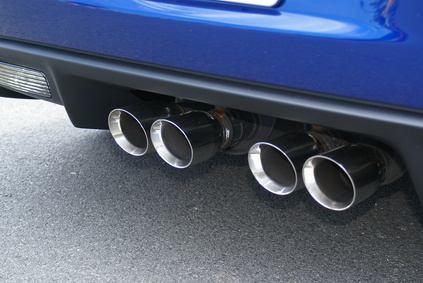All passenger vehicles emit harmful and toxic emissions. Some newer vehicles, like hybrid models, produce much less harmful emissions. But the fact remains that every engine that uses internal combustion emits some type of harmful substance into the air. Since we breathe air, we rely on manufacturers to produce cars that leave small carbon footprints. "Green" has been used as a catchword when it pertains to how clean a vehicle runs. We can increase our awareness of potentially hazardous emissions if we first know what they consist of.

Hydrogen carbon results from the product of unburned gas that reaches the atmosphere through the tailpipe. Engines that run too rich, or combustion that has been interrupted momentarily produce a raw state of gasoline vapor that gives off toxic fumes. Weak ignition and suppressed spark can let raw gas pass without breaking it down into lesser by-product molecules.

Carbon monoxide results when burned particles enter into an oxidative reaction. If the oxidizer does not appear in sufficient amounts to oxidize the particles or compounds completely, they do not transform into CO2, but become harmful carbon monoxide vapors. These vapors produce illness and death in humans if inhaled for long periods.

Nitrogen oxide does not result from unburned particles, as do HC and CO. The chemicals of nitrogen and oxide reside in the atmospheric air. When they combine with the by-products of combustion, N2 and O2, a chemical reaction occurs that transforms them into deadly NOx vapors. It requires high temperature conditions for the two to react, and such temperatures result from the heat generated by the internal combustion engine. NOx intensifies and becomes more concentrated with the higher the temperature.

The last stage in the oxidation of gasoline combustion produces carbon dioxide. It results with a mixture of gasoline carbon and O2. The properties of CO2 ordinarily remain harmless in small amounts. For example, humans and animals give off CO2 during the respiration process. But a balance exists because of all the plants, fungus and algae that require CO2 to sustain themselves. CO2 becomes a problem when the balance becomes one-sided. When this happens, too much CO2 collects in the atmosphere, trapping sunlight which leads to the "greenhouse effect." Global warning results.

Soot consists of burnt particulate matter that comes in very small particles. Diesel engines give off more soot particles than gasoline engines in the form of PM (microscopic versions of soot material). Therefore, regulation and standards of diesel engines exist to decrease these solid contaminants. Soot can travel on airborne currents for long distances; they impede breathing and clog delicate air sacks in the lung tissue.

Auto emissions also emit small quantities of other chemical components, such as N2O, formic acid, 1,3 butadience and traces of acetaldehyde. These emissions must be in large quantities to harm the human body, but the fact remains they will always be a potential hazard and might be regulated one day like the other more prevalent emissions.
